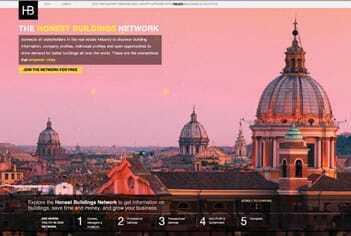Finding detailed information on buildings—as well as the companies and people associated with them—is expensive, time consuming, and often difficult. But a new website, Honestbuildings.com, is intended to make such information as easy to find—and relationships as easy to build—as it is to look up old college roommates on Facebook. Riggs Kubiak, former director of sustainability for Tishman Speyer Properties in New York City, developed the Honest Buildings Network in 2011 with cofounders Cody Roberts and Garrett Kubiak.
The web-based platform, which has been described by Forbes as a combination of Yelp and LinkedIn for greener buildings, connects owners, occupants, and service providers to each other as well as to the buildings in which they live and work. It covers all categories of real estate, including office, residential, retail, industrial, and institutional buildings. “We are focused on the very large community of real estate professionals, whose output accounts for around 15 percent of U.S. GDP,” Riggs Kubiak says. “If we focus on engaging the professional community, they will provide valuable information for the public at large.”
Honest Buildings includes a profile for buildings with photographs and statistics on construction dates, assessed and market values, Energy Star ratings, and Leadership in Energy and Environmental Design (LEED) certifications. The site also provides links to people associated with the building, including tenants and contractors. Owners can claim their buildings and add information to populate the profile, enabling them to show off attributes and amenities, and potentially increase exposure for and interest in their projects. Building service providers, trade associations, vendors, nonprofits, and other organizations can create their own profiles to display their portfolio of projects, highlight their accomplishments, and network with colleagues and prospective clients. These projects then are linked to the appropriate building profiles.
Building profiles are also fed by information through partnerships with public and private entities, such as municipalities, the U.S. Green Building Council (USGBC), the U.S. Environmental Protection Agency (EPA), and real estate companies. As of September, the site contained detailed data on more than 700,000 buildings in Austin, Dallas, Houston, Los Angeles, New York City, Portland, San Francisco, Seattle, and Washington, D.C. In early September, the startup also announced its first round of financing from venture capital firms RockPort Capital and Mohr Davidow Ventures, according to the Commercial Observer online news service.
In addition to venture capital backing, the site generates significant revenue through its premium memberships—a platform that allows service providers and vendors to receive requests for qualifications (RFQs) and requests for proposals (RFPs), and to submit bids for projects. The RFQs and RFPs can be submitted by all users and range from opportunities in purchasing, selling, and leasing to energy audits, retrofits, and renovations. To gain access to these opportunities, premium members pay an annual fee—ranging from $3,000 to $100,000, according to The Real Deal online news service—that varies based on the desired amount of market coverage. Premium members may also become featured search results on the site, allowing for targeted advertising in select markets.
Members of the public can interact with the site, browse buildings, and leave reviews, which may be useful when people and companies are thinking of buying or renting space in a building.
Data transparency in the real estate industry will create “exponentially greater efficiency” in many areas, according to Kubiak. For the half-million buildings that have a complete profile, users can type an address into the website and get access to—at no charge—information about the building’s construction, energy use, leasing agent, architecture, history, maintenance and remodeling projects performed, and all companies that designed, constructed, or performed services on the building. In addition, the site rates buildings on their environmental and sustainability characteristics under a system called the Honesty Rating. A building’s Honesty Rating is formulated not only by how the structure fares on publicly available data like LEED certifications, but also by how individuals rate it on personal experience and interaction.
“Greater transparency will catalyze demand for high-performance buildings, accelerating the rate they adopt all sorts of best practices in order to command the best leasing rates,” says Kubiak. “From energy efficiency to leasing to design to management, buildings will have to get better, faster.”
The site lists detailed information obtained from the USGBC, the EPA, and municipalities about commercial buildings’ energy efficiency and consumption. For example, a site user looking up the Empire State Building in New York City can see details on the building’s certifications and awards, including its Energy Star rating and its LEED certificate date and level. The building is also linked on the site to various projects, including the Empire State Building energy retrofit completed in 2010 and Lutron’s work on the building’s lighting system.
This sort of information may become particularly valuable as more cities begin to require commercial buildings to disclose their energy consumption. The trend toward requiring disclosure is gaining momentum throughout the country, increasing the amount of information available to the public.
Traditionally this type of information has been difficult to find—or unreliable—but Honest Buildings may serve as a powerful tool for increasing energy awareness because it compiles information from a variety of reliable sources. Also, members of the public have the ability to dispute incorrect information or add new information. Not only can this information catalyze demand for high-performance buildings and retrofits, it also can accelerate the pace at which building owners and tenants adopt best practices for operations.
Linking Professionals
However, information on energy consumption is just a small piece of what Honest Buildings offers. The site also seeks to transform the way real estate professionals interact with each other. “We believe that the most powerful information comes from personal relationships, especially in the real estate industry, and by bringing these personal connections online we are giving professionals the ability to leverage these relationships into new opportunities,” says Kubiak.
When choosing building professionals to work with, owners and managers frequently go to people they already know, or they spend a lot of time and resources to find new professionals. Even when owners and managers are working with companies they are familiar with, the RFP process is often inefficient and cumbersome, and it is difficult to know if the highest quality or price was obtained because there is often little or no information available for comparison.
According to Kubiak, leaders of most of Honest Buildings’ member companies say referrals are the number-one way they find their next customer. This process is important, but extremely inefficient because most of the real estate industry is not connected by a comprehensive network. “Currently, the process of information gathering often costs real estate professionals thousands of dollars in data subscriptions and months of time and resources,” Kubiak says. “So to start we want to make that process dead simple and free.”
Through Honest Buildings, the word-of-mouth approach will be brought online. The site features a patent-pending qualification engine, which gives businesses depth and breadth in their search for a service provider. Project owners can search for companies based on dozens of attributes and weigh the categories that are most important to them. “Honest Buildings provides a networking platform that exponentially increases the power and reach” of the word-of-mouth approach, Kubiak says. “Now anyone can stumble across [a referral] while looking at a building profile, comparing projects, viewing somebody’s personal network.” (Members can join Honest Buildings by supplying their e-mail contact information, or they can sign up through LinkedIn or Facebook.) “The services and technologies with the best track record can leverage a network effect to capture more and more business,” Kubiak says.
Kubiak points to many companies that create simple but powerful products that can maintain optimal building performance and reduce operating expenses. “The mission of Honest Buildings is to be the networking platform for the real estate industry so these types of innovative companies can be discovered and scale faster, leading to better buildings, happier people, and a healthier planet,” he says.
Kubiak cites the music industry as an example to look to when considering how the internet could transform the real estate market. “There are of course many significant differences between real estate and music, but one striking similarity is how much the music industry used to be—and the real estate industry still is—a relationship business,” he says. The internet exploded this model for the music industry, he notes, as iTunes and other sources gave people access to any song in the world. “I think technology is going to do exactly that for real estate and allow for much more mobility for small and medium companies to scale into large and megacompanies because everyone will have access to more information.”
The Honest Buildings team will continue collecting data on commercial buildings and hopes to launch in every major city in the United States as well as internationally over the next year. “We see a huge opportunity to connect real estate professionals and the very fragmented marketplace for real estate information, but we know we have to stay laser-focused on providing immediate value to our customers. So it’s a balancing act of thinking big but executing on the small stuff that is going to help us grow into realizing this big opportunity,” Kubiak says. As more real estate professionals are connected and engaged, the fragmented marketplace of information may turn into a very powerful network of relationships and knowledge.





